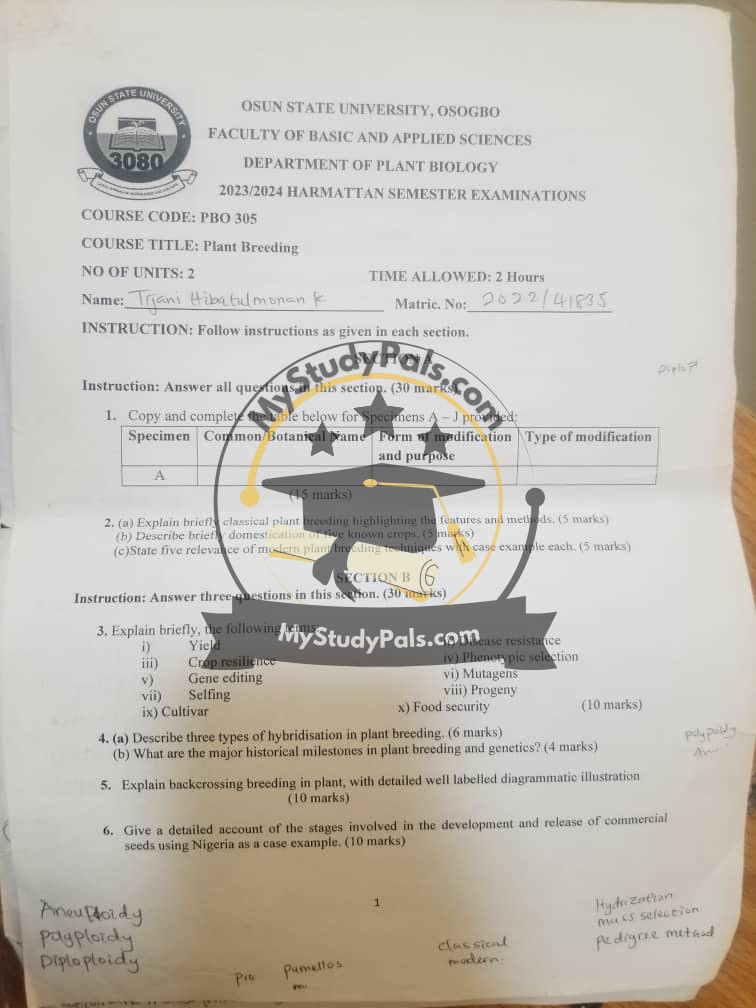ANWSER
Question 1:
Answer:
(Since actual specimens A–J are not provided in the image, I will provide a general template example. Fill in the specific details based on the specimens shown during the exam.)
| Specimen | Common/Botanical Name | Form of Modification and Purpose | Type of Modification |
|---|---|---|---|
| A | Cassava (Manihot esculenta) | Enlargement of storage root for food | Morphological |
| B | Sugarcane (Saccharum officinarum) | Increased sugar content through hybridization | Genetic |
| C | Irish Potato (Solanum tuberosum) | Enlarged stem tuber for propagation and food | Morphological |
| D | Carrot (Daucus carota) | Root thickening for consumption | Morphological |
| E | Tomato (Solanum lycopersicum) | Resistance to pests through gene editing | Genetic |
| F | Onion (Allium cepa) | Modified bulb for nutrient storage | Morphological |
| G | Banana (Musa spp.) | Sterility for seedless fruit through polyploidy | Genetic |
| H | Maize (Zea mays) | Increased yield via hybrid breeding | Genetic |
| I | Yam (Dioscorea spp.) | Tuber enlargement | Morphological |
| J | Cowpea (Vigna unguiculata) | Resistance to bruchid pest | Genetic |
Question 2:
(a) Classical plant breeding is the process of selecting plants with desirable traits and crossing them to produce offspring with improved characteristics. It involves hybridization, selection, and propagation. Features include reliance on phenotypic traits, natural variation, and traditional methods such as mass and pure-line selection.
(b) Five domesticated crops and brief descriptions:
- Maize – Domesticated from teosinte in Mesoamerica.
- Wheat – Domesticated in the Fertile Crescent; major staple food.
- Rice – Originated in Asia; adapted for wet environments.
- Potato – Domesticated in the Andes; cultivated for tubers.
- Tomato – Native to South America; bred for fruit quality.
(c) Five relevance of modern plant breeding techniques (with case examples):
- Increased yield – Use of hybrid maize.
- Disease resistance – GM cotton resistant to bollworm.
- Drought tolerance – Development of drought-tolerant rice.
- Improved nutrition – Golden rice rich in Vitamin A.
- Reduced pesticide use – Bt corn engineered for pest resistance.
Question 3:
Answer:
i) Yield – The amount of crop produced per unit area.
ii) Disease resistance – The ability of a plant to prevent or reduce disease infection.
iii) Crop resilience – Capacity of a crop to withstand environmental stresses.
iv) Phenotypic selection – Choosing individuals based on observable traits.
v) Gene editing – Precise alteration of DNA sequences (e.g., CRISPR).
vi) Mutagens – Agents causing mutations (e.g., radiation, chemicals).
vii) Selfing – Self-pollination in plants, leading to homozygosity.
viii) Progeny – Offspring resulting from breeding.
ix) Cultivar – A plant variety that has been produced by selective breeding.
x) Food security – Reliable access to sufficient, safe, and nutritious food.
Question 4:
(a) Three types of hybridization:
- Inter-varietal hybridization – Between different varieties of the same species.
- Interspecific hybridization – Between different species within the same genus.
- Intergeneric hybridization – Between different genera.
(b) Major historical milestones:
- Gregor Mendel’s laws (1866) – Foundation of genetics.
- Rediscovery of Mendel’s work (1900).
- Development of hybrid maize (1920s).
- Introduction of mutation breeding (1930s).
- Use of molecular markers and GMOs (1980s–present).
Question 5:
Answer:
Backcross breeding involves crossing a hybrid offspring with one of its parents to retain desired traits of the recurrent parent while introducing a new trait from the donor parent.
Steps (with diagram illustration suggested):
- Cross recurrent parent (R) with donor parent (D).
- F₁ generation obtained.
- F₁ is backcrossed to R → BC₁.
- Select individuals with the target trait.
- Repeated backcrossing for several generations.
- Final selection of plants with desired trait and genetic makeup similar to R.
Question 6:
Answer:
Stages in commercial seed development using Nigeria as a case study:
- Germplasm collection and evaluation – Assembling and testing local and exotic varieties.
- Breeding and selection – Use of hybridization and selection for desirable traits.
- Varietal testing – Conducting multilocational trials under different agro-ecologies.
- Release and registration – National Varietal Release Committee approval.
- Seed multiplication – Breeder → Foundation → Certified seed production.
- Distribution and marketing – Involving agencies like NASC and private seed companies.
- Monitoring and quality control – Ensuring seed purity and viability through inspection.


